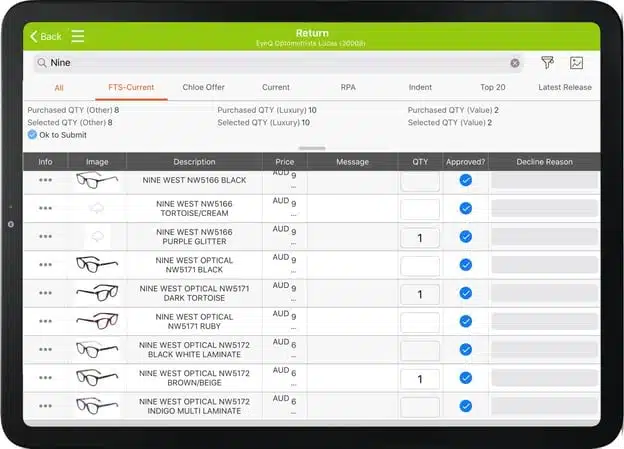Returns Made Simple: The Configurable Workflow Driving B2B e-Commerce Success
April 24, 2023 By Yana Persky

Returns are an inevitable part of the retail industry, and the eyewear industry is no exception. In recent years, the eyewear industry has experienced a significant increase in returns. The returns rate varies across different countries and can be influenced by factors such as consumer behavior, cultural norms and local regulations. However, a return rate that could be as high as 25% is quite common in the eyewear industry.
This suggests that returns are a significant concern for eyewear retailers.
Why do eyewear retailers have a high returns rate?
There are several reasons why eyewear retailers may have a high returns rate:
- Fit and Comfort: Eyewear is a highly personalized product, and it can be challenging to find the right fit and comfort level for each individual. This can lead to a high return rate, as customers may need to try multiple frames or sizes before finding the right fit.
- Online Purchases: With the rise of e-Commerce, more customers are purchasing glasses online which can lead to a higher return rate. Without the ability to try on frames in person, customers may be more likely to return items that do not meet their expectations or fit properly.
- Changing Fashion Trends: Eyewear is also a fashion accessory, and trends in style and design can change quickly. Retailers may need to constantly update their inventory to stay on top of these trends, which can lead to a higher return rate for items that may no longer be in demand.
What is a rotation policy?
Many eyewear distributors offer a rotation policy for frames that do not sell well. This policy allows retailers to return slow-moving inventory to the distributor in exchange for new inventory that may be more popular with customers. This helps retailers manage their inventory levels and ensures that they always have a fresh selection of frames to offer their customers.
Eyewear distributors typically offer the rotation policy to their retail customers, which can include both brick-and-mortar stores and online retailers. The policy may be subject to certain terms and conditions, such as a minimum order quantity or a time limit on returns.
The specifics of the rotation policy may vary depending on the distributor, but in general, it allows retailers to exchange frames that are not selling well for new frames from the distributor’s inventory. This helps distributors manage their inventory levels and reduce waste, while also providing value to their retail customers by allowing them to keep their inventory up-to-date with the latest styles and trends.
However, this policy can come at a high cost to the distributor, who must configure additional business processes to support return-related activities. These may include stock movement and updates, approvals, physical condition of returned items, repackaging, and shipping.
Solution
Eyewear distributors are increasingly implementing B2B e-Commerce solutions with self-service return mechanisms that allow their customers to initiate return requests using configurable workflows.
Having a configurable returns workflow is crucial to ensuring that returned merchandise is processed efficiently and quickly, while also minimizing the impact on the retailer’s bottom line.
Here’s a closer look at how configurable returns workflows function in the eyewear industry:
- Creating a Return Policy: The first step is to establish a clear and concise return policy that outlines the conditions for returning merchandise. This includes specifying the time frame in which returns are accepted, the condition the item must be in for a return, and any associated fees or charges.
- Configuring the Returns Workflow: Once the return policy is established, distributors can then configure their returns workflow to meet their specific needs. This includes configuring the workflow to accommodate different types of returns, such as defective merchandise, inaccurate sizing, or customer dissatisfaction.
- Submitting Returns: B2B eyewear buyers submit their own requests for returned merchandise through an online portal according to the predefined rules and criteria for returns. This portal may be accessed through a web browser or a mobile app.
- Returning Merchandise to the Distributor: The returned merchandise is sent back to the distributor.
- Refunding or Exchanging Merchandise: Once the distributor receives the returned merchandise, they can either issue a refund or exchange the items for different ones.
Marchon Australia, for example, sought to create a more controlled returns experience across their different sales channels.
A new returns workflow created consistency and boosted efficiency across multiple sales channels by having all returns-related info in one place.
Non-authorized returns were significantly reduced as a result of allowing customers to submit their own requests for returned merchandise authorization using pre-defined rules and criteria.
Takeaways
Eyewear distributors can implement a configurable returns workflow to streamline their returns processes and improve the overall efficiency of their operations. There are several key benefits to using automated returns workflows, including:
Speed and Efficiency: By automating many of the manual processes involved in returns management, distributors can reduce the time and resources required to process returns, which can lead to faster resolution times and lower costs.
Consistency: Returns workflows reduce the likelihood of disputes or misunderstandings related to returns. By leveraging predefined rules and criteria, distributors can ensure that returns are handled consistently across all sales channels.
Accuracy: By automating many of the manual processes involved in returns management, distributors can reduce the risk of errors or mistakes in the returns process.
Customer Satisfaction: By automating many of the manual processes involved in returns management, distributors can provide customers with a seamless returns experience that is fast, easy and hassle-free.
Overall, the trend towards configurable returns workflows is likely to continue as eyewear distributors seek to improve their returns processes, reduce costs and provide a better customer experience. By leveraging the right technology and analytics, distributors can optimize their returns management processes and improve overall business performance.


























